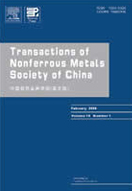Phase evolution of 17(Cu-10Ni)-(NiFe2O4-10NiO) cermet inert anode during aluminum electrolysis
(State Key Laboratory for Powder Metallurgy, Central South University, Changsha 410083, China)
Abstract: 17(Cu-10Ni)-(NiFe2O4-10NiO) cermets were prepared by cold pressing and sintering in nitrogen atmosphere, and tested as inert anode for aluminum electrolysis at 960 °C for 10 and 40 h, respectively. Microstruc, tures and phase compositions of the as-sintered and post-electrolyzed samples were investigated. The impurity contents in the electrolyte and the cathode metal were detected in order to investigate the corrosion characteristic of the elements of Fe, Ni and Cu in the anode. A dense NiFe2O4 layer was observed on the surface of anode and thickened with prolonging the electrolysis time. In the newly formed dense ceramic layer, NiO phase disappeared as a result of being swallowed by NiFe2O4 phase, and the metal phase was oxidized during the electrolysis in which Cu element showed a higher dissolution rate than Fe and Ni elements. The formation process of the dense ceramic layer during the electrolysis was presented and explained by using the corrosion mode of the metal phase and the transformation mechanism from NiO phase to NiFe2O4 phase.
Key words: inert anode; spinel; phase transformation; aluminum electrolysis

